If you haven’t noticed, there’s a volcano in Iceland still going strong. It’s a great tourist volcano – it’s fairly small and it’s pretty but mostly not dangerous. It’s producing a bit of gas and every now and then it has to be closed because of the volume of gas builds up but the lava is about as safe as live, moving lava gets and I wish I could be there. But since I can’t, I’m going to talk about Inside the Volcano, another nearby volcano that, as per the name, you can go inside.
Its name is Þríhnúkagígur. It’s not as bad as it looks. Three-nooka-gig-ur, only the g’s are kind of more like y’s. It means Three Peaks Crater and 99% of the time, you’ll hear it referred to simply as “inside the volcano”. But it does have a name and it deserves for its name to be known. It’s unique at the moment – it’s the only known volcano in the world with an empty magma chamber that humans can visit. No one knows why it’s empty. Did it drain away through some crack or crevice hidden away in the floor? Did it set and the floor is just the solid top of the magma? Did it manage to empty itself? Whatever happened, we’re left with an empty magma chamber and that’s fascinating both from a scientific and a tourist point of view.
Inside the Volcano is probably the most expensive half-day trip I’ve ever done (it’s currently 44,000 ISK, about £253/€291/$353. It was 370,000 ISK when I did it but I don’t have the historical conversion rate to see how much that was) but back in 2012, which is when I did it, they said it was only going to be open for six weeks and I figured I’d pay that for a once-in-a-lifetime opportunity. I’m not going to lie, I still purse my lips and shake my head when I think that nine years later, it’s still open. Awesome as it is, that was supposed to be my unique trip that no one else had done or could do.
You get picked up from your door in Reykjavik and carted by minibus out to the meeting point out at Bláfjöll. You can drive there yourself if you have a car and you really want to but you can’t drive to the volcano. You have to walk the two miles from the meeting point to the volcano, across the lava field and that in itself is an experience. It’s all pretty flat but it’s not very even. You pass some semi-collapsed lava tubes and you cross a crack in the fabric of the Earth, from the Eurasian tectonic plate to the North American plate. There’s a place where you have to take what we used to call “a bold step” in my caving days and there are places where you can just scramble across with no difficulty whatsoever but it’s amazing to literally step from one plate to another with your own feet. The lava tubes are also interesting, although perhaps moreso to a caver than to an average person. Our guides let us stop to explore them further on the way back because our guides were wonderful.

This tour goes whatever the weather. I don’t think it rains much inside the volcano but you might well find yourself hiking in some appalling weather. You need decent shoes. Not necessarily proper mountain boots but you can’t turn up in heels or flipflops. You want something reasonably solid that can cope with uneven lava field and the even more uneven floor of the magma chamber. I noted in my diary that there was “even a pair of pretty little black leather heeled boots of the kind you wear for a shopping trip” in my group, among plenty of trainers. From the tone, I evidently disapproved of the trainers. 2021 Juliet says go for it. Maybe boots are better but trainers will do the job just fine. The pretty little leather heeled boots, no. That’s not suitable footwear for this trip. It’s not suitable for Iceland full stop, not if you’re going outside downtown Reykjavik.
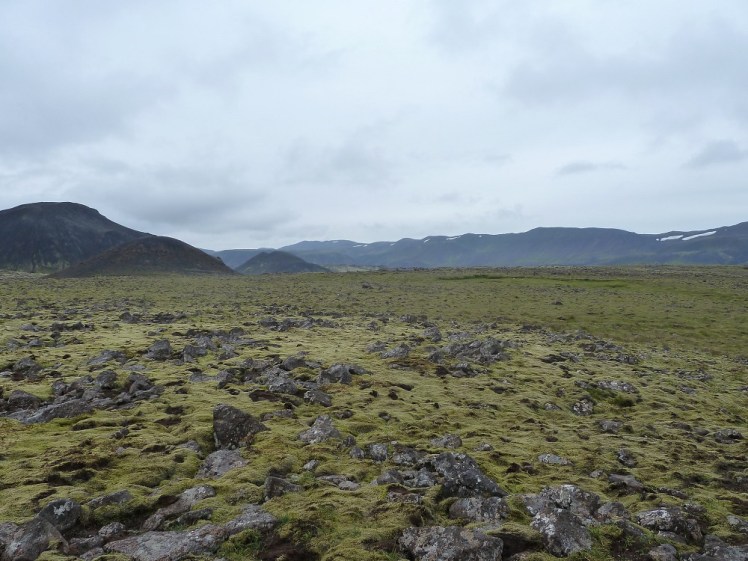
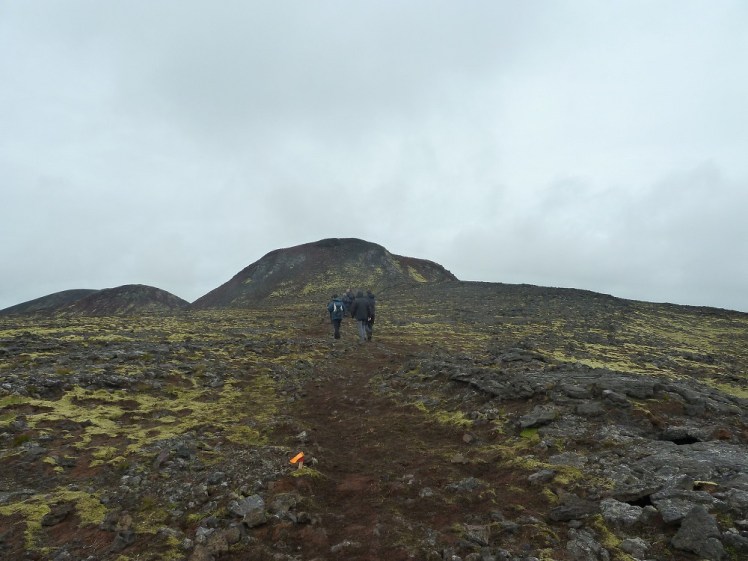
The hike takes 40-50 minutes, depending on the speed of the group and then you find yourself at Inside the Volcano’s base. We were split into two groups and equipped with harnesses, helmets and headlights and then the first of the two smaller groups was led up to the top of the volcano. From the outside, it is indeed a mountain of three peaks, fairly small and humpy and it only takes a couple of minutes to walk to the top. It’s reddish scoria that crunches under your feet. The website says to bring a camera and you can take as many pictures as you want and I don’t know if it’s the same nine years later but we weren’t allowed to take bags into the magma chamber and anything we did take had to be physically attached to us. I’d seen that on the website when I booked and I’d had the foresight to bring a tether for my camera so I was just about the only one of our group to be able to take photos at the top.

We were to descend in a kind of basket, a narrow metal box not dissimilar to the kind of box used for washing windows on skyscrapers. That’s why we’d split into two groups – you could only physically fit about six people in it and to get to it we had to walk out on a wobbly gangplank right over the mouth of the chasm below. I think I might have gone first. I do have a habit of going “oh, fine, I’ll do it!” when I’m with a group that’s been asked for a volunteer and the rest of the group is pretending they didn’t hear anything. Your harness is clipped to a safety line as you walk the gangplank and then you’re attached to the basket once you’re in it. I wasn’t bothered about falling off anything. It’s all got railings and high sides and whatnot. I was more concerned about the things falling while I was on them. But it all stayed in place and the rest of the group made their way out too and then we were ready to go.


The entrance to the magma chamber is a very narrow slot. It’s so narrow that the basket has wheels mounted on the sides to help it slide through and once you’re beyond that, the chamber gradually bells out. From touching the sides at the top, you’re suddenly hanging in thin air inside the volcano with the walls a very long way away. The lights of the team at the bottom, and the previous tour group, are just little white glows in the dark at first and then by the time you reach the bottom, 120m and about six minutes later, that slot at the top is just a star in the dark above your head.


It’s an incredible sight. They’ve put spotlights around the crater floor to illuminate the huge walls and it’s like a cathedral. It’s stained with yellow and orange and black splashes, evidence of sulphur and iron and scorching and if I’d thought about it at the time, I bet it smells phenomenal. There’s space inside to put the tower of Hallgrimskirkja, the big grey space shuttle-shaped church in central Reykjavik. It’s too big, really, to properly understand.
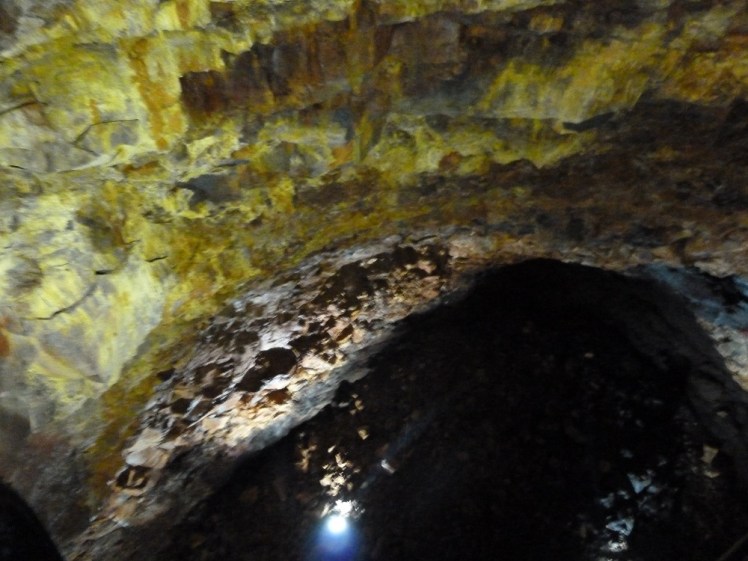


I took my time looking around and taking photos and appreciating the cavern but then I gave into my caving instincts. I’d seen the survey of the cavern and I knew that we’d landed on a kind of hill in the middle and that there were some kind of tunnels down the sides. I wasn’t going to cave properly in them. Apart from the fact that I was in a t-shirt and a slightly wobbly helmet, it’s lunacy to go off exploring a cave alone, especially when you might stumble on the missing magma at any point. But I wanted to a little deeper into the magma chamber than the rest of my group. I wanted to find a hole and sit in it and look down and see if I could see a little more than anyone else. In fact, our guide had told us that if we wanted to scramble down the rocks at the side where the chamber dropped, we could go down to where it narrowed so much you had to crawl and you could get good photos from down there. So I had my guide’s blessing to stick my caver nose into the narrow corners and I had my caver sense to know not to do anything stupid. He was right, it was a good photo spot. If only my best one had actually been in focus. In fact, to be honest, a lot of my photos were either out of focus or misty from the humidity.



I wish we could have had more time inside the volcano. The website says you get about half an hour deep under the ground but it didn’t feel like it. But by the time we were packed back into the basket and ascending, I had a better idea of what I was seeing. The little lights on the ground were the landing spot and the spotlights and the staff and tourists wandering around and I could pick out which of those each individual light was. I took selfies in the basket – I thought I took them while I was waiting for everyone else to get in but judging by where they are in the photostream, it looks like I took them in mid-air. We rumbled so carefully through the narrow spot at the top and then there we were, back in the real world, standing on top of a small mountain in the drizzle. And it is a small mountain. It’s about 35m high which means that even the landing spot, the highest point in the bottom, is 85m below the surface. To put it another way, you could stand the Statue of Liberty on that landing spot and the top of her torch wouldn’t reach the entrance, not by a long way. There’s nearly three times as much below the surface as above and once you realise that, you start to look at other volcanoes a little differently. And that’s just the bit that’s fairly easily accessible. Who knows what’s down those narrow crawly sides that I sensibly didn’t investigate?

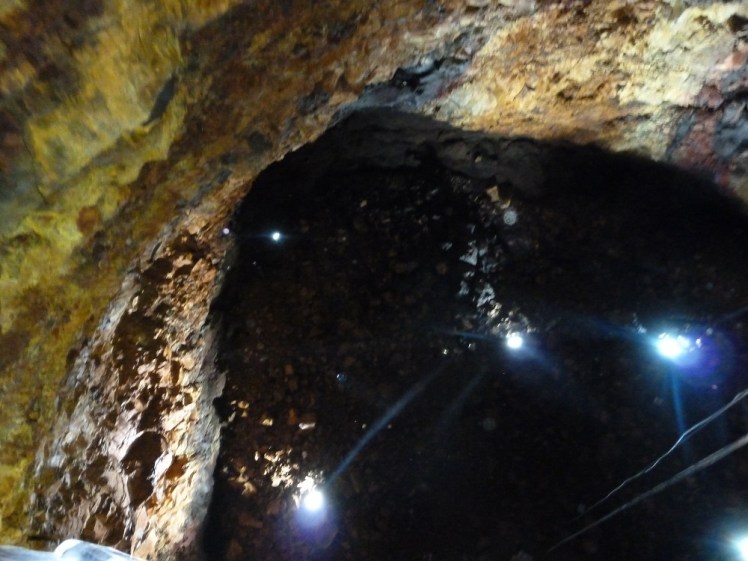


We weren’t done yet. Our second group had gone in and we had to wait for them to emerge and while we did, we were offered “leader sheep soup”. Leader sheep is a thing in Iceland. It’s a sub-breed of the Icelandic sheep, taller and more intelligent than the average sheep, apparently with excellent leadership abilities. It also has a great ability to be made into soup. I didn’t want soup so I begged to be allowed to go and play outside. Actually, although I explored the volcanic landscape, found lava bridges and miniature craters and all sorts of features, mostly I took lots of terrible selfies. Other than the half a dozen people in the huts eating soup and a dozen or so people inside the volcano, probably right under my feet, there’s not a soul for a good few miles and it was absolutely silent. For all its nature, Iceland is rarely quiet and peaceful because anywhere there’s nature, there’s tourists. Not here. I had the lava field to myself for at least half an hour before the rest of my group came out to play too. The second group had to emerge from the volcano and have their soup too.
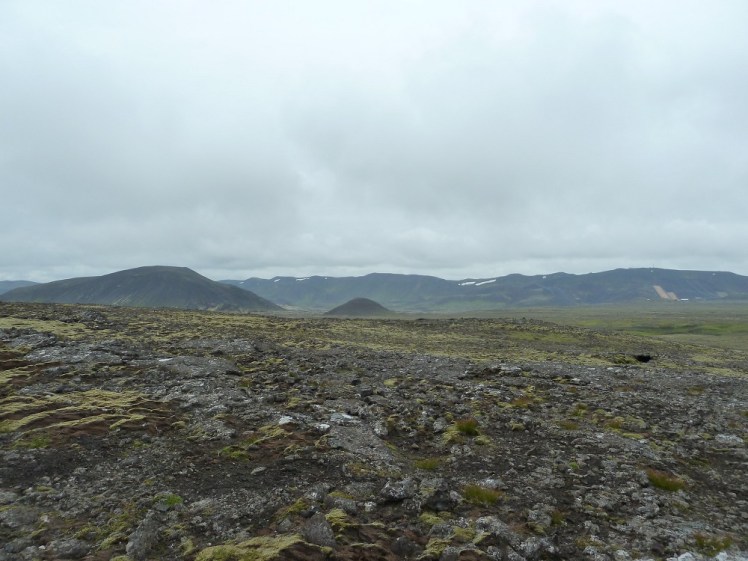

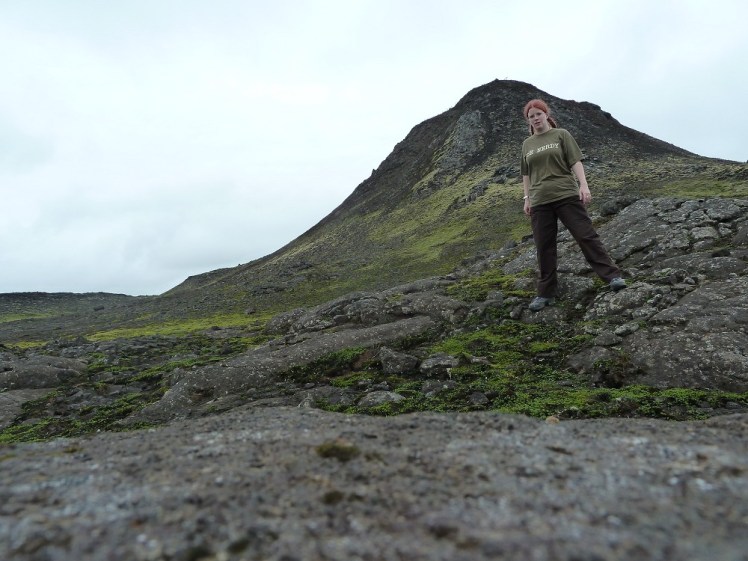
At last we walked back. We discussed caving, one of the group arguing that Iceland must be brilliant for caving and me arguing that it’s probably not as good as he thinks and so our tour leader stopped to let us explore the lava tubes. These ones are open collapsed ones. That’s one of the troubles with lava caves. The ceilings are often very thin and fragile and over the course of a few thousand years, they do often collapse, leaving rounded hollows in the landscape full of orangey rubble that used to be a roof. We visited Long Hole and Deep Hole. Long Hole had four separate open-air sections and in the roofed bits you could see the smooth rounded sides that give these the name lava tubes. Deep Hole wasn’t a lot deeper than Long Hole but it was a bit more awkward and scrambly and there was an entrance in the ceiling with a gate over it to stop anyone falling in. I’m still very appreciative of those guides stopping so I could have a look underground because it’s not part of the official itinerary.



When it’s ok to go back to Iceland, I’m going to spend most of my time with the new volcano but maybe I’ll take half a day to go back to Þríhnúkagígur, if for no other reason than to get some photos that are in focus. I might even treat myself to the helicopter tour, whereby you get flown to the foot of the volcano instead of walking (joke; it’s £511 and you only get 12-20 minutes in the helicopter). But umm… if you want to do a PR/collab thing with an Iceland blogger and give me the helicopter trip for free, you can find my email address on my Contact page and I’ll do a whole new blog with lots of helicopter pictures, hint hint. But yeah, since it’s still running, I’d definitely like to do do Inside the Volcano again.
One thought on “Inside the Volcano”